Labour Law > QUESTIONS & ANSWERS > WGU Employment Law - C233 Study Guide Questions and answers, 100% Accurate, rated A+ (All)
WGU Employment Law - C233 Study Guide Questions and answers, 100% Accurate, rated A+
Document Content and Description Below
WGU Employment Law - C233 Study Guide Questions and answers, 100% Accurate, rated A+ Identify the role of the National Labor Relations Board (NLRB). - ✔✔-a federal agency given power to pol... ice against unfair labor practices and determine whether the union is sanctioned to represent the members. NLRB administers all provisions of the Wagner Act. Primary functions include: conducting union elections (make sure that they are ethically and legally conducted), investigating complaints by employers or unions through their investigations, issuing opinions on it findings and prosecuting violations in court. Remember NLRB investigates all unfair labor practices even in non-union environments. Investigating unfair labor practices connected with Social Media has been a recent focus for the NLRB. What is the National Labor Relations Act, also known as the Wagner Act of 1935? - ✔✔-Pro-union law which: 1. Established the rights of workers to form unions, collective bargain, and to strike. 2. Protected union rights and prohibited employers from interfering, coercing or otherwise intruding on employees interested in the union 3. Established the National Labor Relations Board (NLRB)- Describe the Labor Management Relations Act (LMRA), also known as the Taft-Hartley Act, of 1947. - ✔✔-Pro-employer law which: 1. Curbed unions overreaching or shift some of the power back to the employer; 2. Forbade Unions from using unfair labor practices, for example unions cannot coerce or discriminate against non-union members; 3. Outlawed the closed shop (shop that made union membership a condition of employment). Let employers take back the right to hire. 4. Prohibited wildcat strikes (those not authorized by the union); Further, the "right to work" provision was established, states that had right to work laws had to be honored. The state law prohibits employees to be required to join a union. Gives the employee the choice. Describe the major impacts of the Labor Management Reporting and Disclosure Act, also known as the Landrum-Griffin Act, of 1959. - ✔✔-Increased power of Union Members by: 1. Unions had to give union members a bill of rights; 2. Unions required to hold elections every 3 years; 3. Unions had to submit annual financial reports to the department of labor, federal crime to embezzle or steal union funds. Also, union members could attend union meetings, vote and nominate people for union offices. Define the steps in the union organization process. - ✔✔-1. Union contacts employees or employees contact union. 2. Initial organizational meeting with union to gather employee support. 3. 30% of authorization (employee) signatures are required to move forward with unionization process. 4. Once 30% of signatures are gathered, a secret ballot election is administered by the NLRA. 5. If the vote is "yes" (51% majority), the NLRB certifies the union as the legal bargaining representative of the employees. Describe the collective bargaining process. - ✔✔-Collective bargaining is the negotiations between the employer and the the union (on behalf of the workers) to form a new contract which governs the working relationship between the parties. Under the NLRA, both the union and the employer are required to bargain in good faith. The concept of good faith does not mandate agreement, but instead requires a mutual obligation of the parties to participate actively in negotiations, showing intent to find a basis for agreement. Workplace issues are divided into three categories: mandatory, permissive and illegal bargaining items. Compare unfair labor practices for management and labor. - ✔✔-Management cannot: refuse to bargain with labor; coerce, interfere or intrude on employees' rights to become involved with unions; For unions, they must bargain in good faith. During strike activity, unions are prohibited from preventing persons who wish to work from entering the business, may not damage employer property, and may not picket other businesses that provide goods and services to the employer. Such a picket is called a secondary picket. Describe the following strategies to resolve labor disputes: Lockout - ✔✔-the employer either shuts down business operations and prevents employees from coming to work or continues work but hires replacement employees Describe the following strategies to resolve labor disputes: Strikes - ✔✔-a mass work stoppage; economic strikes (used to pressure management into conceding to compensation demands) and ULP strikes (employer committed ULP) are lawful. Wildcat strikes, in which employees stop work without the union's permission, are illegal. Describe the following strategies to resolve labor disputes: Mediation - ✔✔-voluntary process, bringing a neutral third-party into a negotiation as a facilitator. It may or may not lead to an agreement between the parties Describe the following strategies to resolve labor disputes: Arbitration - ✔✔-process agreed to by the parties in which, at its conclusion, a neutral third-party will impose a binding agreement on both parties Summarize worker eligibility and E-verify. - ✔✔-E-verify is used to allow employer to determine eligibility of an employee to work in US. They have to submit form I-9 and have to submit it within 3 days and keep in their records. Contractors with $100,000 or more/or 120 days or longer from Federal government contracts must use e-verify. Other employers, optional. If e-verify gives non-confirmation, candidate has 8 days to respond. (employer has to wait out that 8 days) Explain negligent hiring. - ✔✔-Negligent hiring is when an employer ignores a reputation or record of an applicant and still hires them for the job, and then something negative occurs. In a sense, the employer shares the blame in this situation. Explain a negligent referral. - ✔✔-Negligent referral occurs when an employer who is providing untrue reference omitted dangerous or criminal behavior. Meaning by suggesting someone to do a job but not giving the person that is hiring the full background on the past employee's behavior, when harm occurred on the job, the referring employer was negligent. Explain negligent retention. - ✔✔-Negligent retention is that the employer fails to terminate or remove an employee that poses a danger. Define the Fair Labor Standards Act (FLSA) and its main parts. - ✔✔-FLSA established minimum wage, overtime pay, record keeping, and youth employment standards affecting full-time and part-time workers in the private sector and in Federal, State, and local governments. For added detail: 1. Set overtime pay at 1.5 times the usual hourly wage for non-exempt employees for hours worked over 40 in a week 2. Defined exempt and non-exempt standards; general exemption is established by high degree of responsibility, supervises at least 1 person and uses judgment/decision-making in role 3. Child labor laws may restrict hours and times of day for work, varying by age and during/outside of school year Describe the Immigration Reform and Control Act (IRCA). - ✔✔-IRCA preventing illegal employment of aliens to employers. Unlawful if have 4 or more employees to hire undocumented workers. Within 3 operational business days (72 hours) must verify eligible to work in the US Form I9. Prohibits discrimination in employment on the basis of national origin or citizenships Explain the rules associated with the Worker Adjustment Retraining Notification (WARN) Act. - ✔✔- WARN rules is employers with over 100 employees has to give a detailed written advance notice of plant closing or mass layoff also 60 days prior to closing & prohibited to close before. Caution: the 100 employees could be laid off over a month or two if the employer is sneaky; this would still qualify as needing the 60 day WARN notice. Plants must be within 75 miles of each other. Explain the exceptions to the WARN Act. - ✔✔-3 separate exceptions: 1. natural disaster (flood, fire, tornado, etc) 2. faltering company (giving notice would decrease the chance of the company getting funding they are seeking to stay open) 3. unforeseeable business circumstances--sudden negative change such as cancellation of a major contract Describe the requirements placed upon employers by the Occupational Safety and Health Act (OSHA). - ✔✔-Requirements include providing a workplace free from serious recognized hazards and complying with standards, rules and regulations issued under the OSH Act; making sure employees have and use safe tools and equipment and properly maintain this equipment; using color codes, posters, labels or signs to warn employees of potential hazard [Show More]
Last updated: 1 year ago
Preview 1 out of 11 pages
Instant download
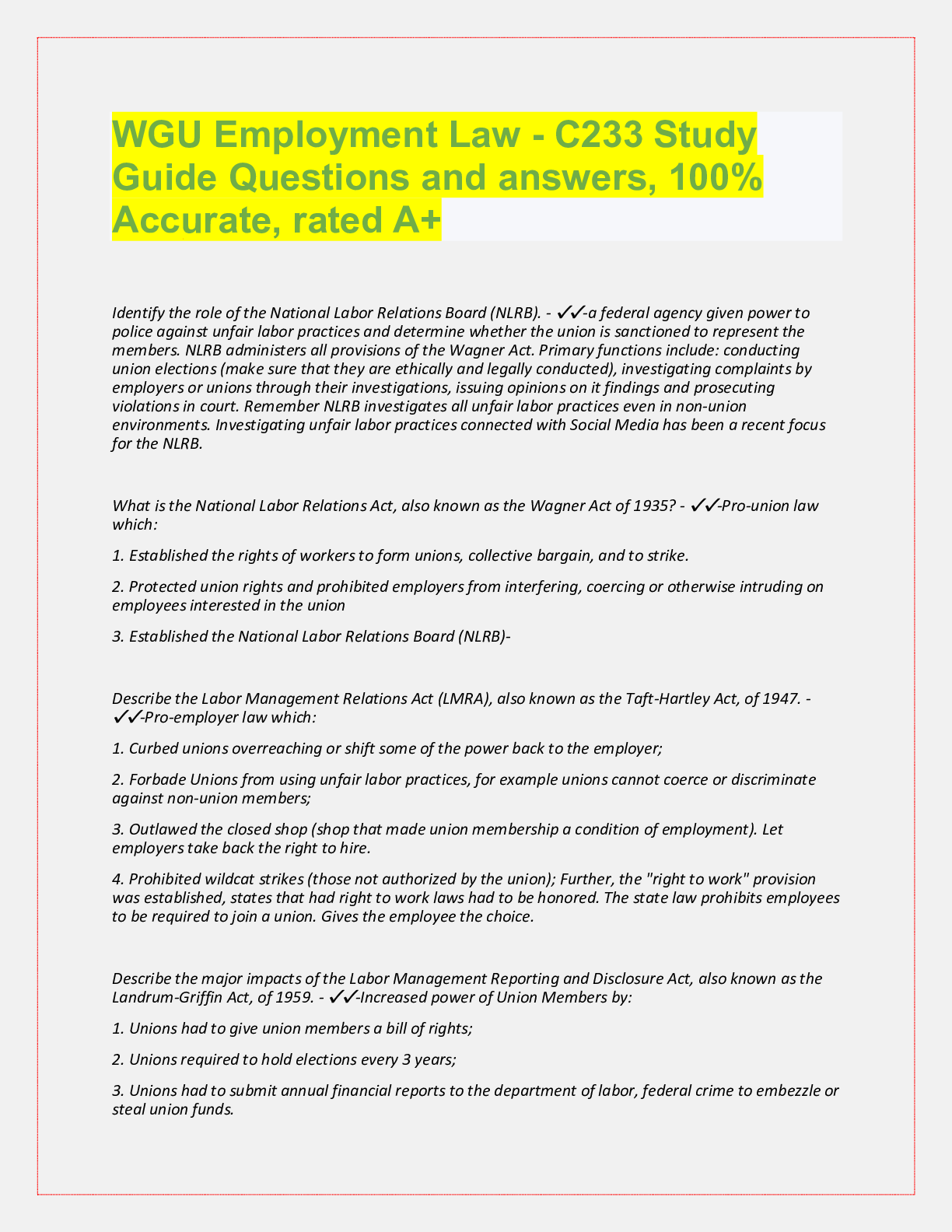
Buy this document to get the full access instantly
Instant Download Access after purchase
Add to cartInstant download
Also available in bundle (1)
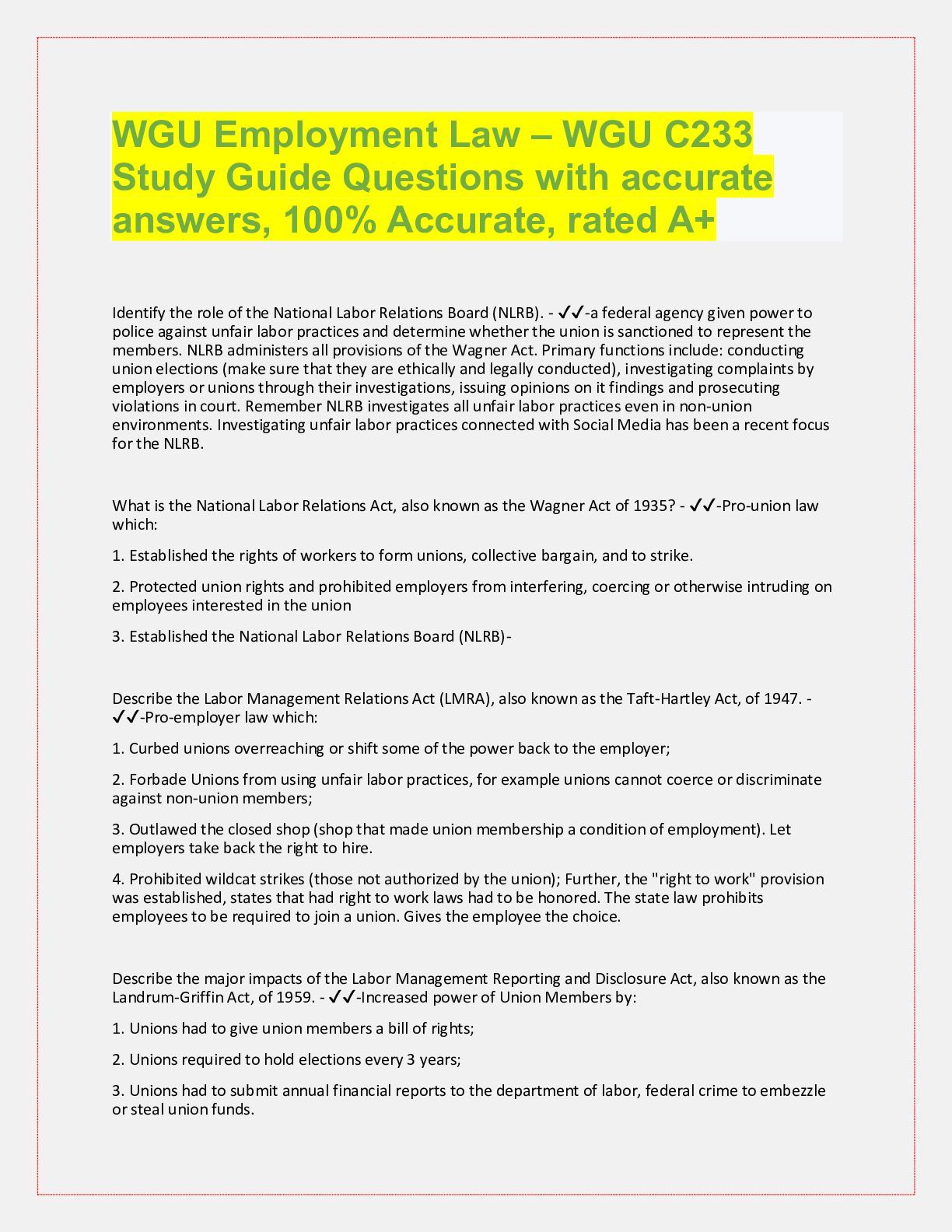
WGU C233 EXAM BUNDLE, VERIFIED
WGU C233 Employment Law, Exam Questions with accurate answers, rated A+. 39 VERSIONS, APPROVED PASS RATE
By Topmark 1 year ago
$35
32
Reviews( 0 )
Document information
Connected school, study & course
About the document
Uploaded On
Mar 13, 2023
Number of pages
11
Written in
Additional information
This document has been written for:
Uploaded
Mar 13, 2023
Downloads
0
Views
50






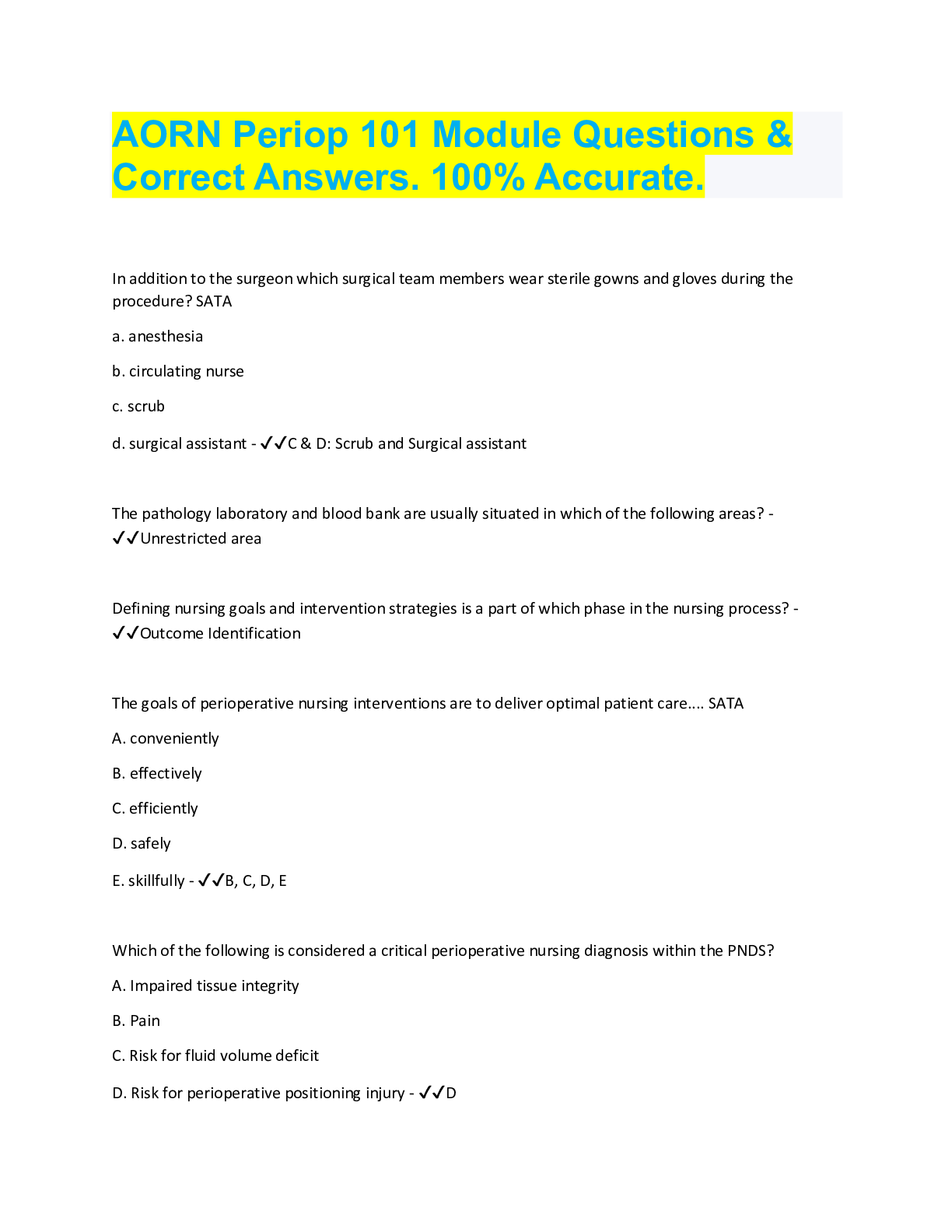





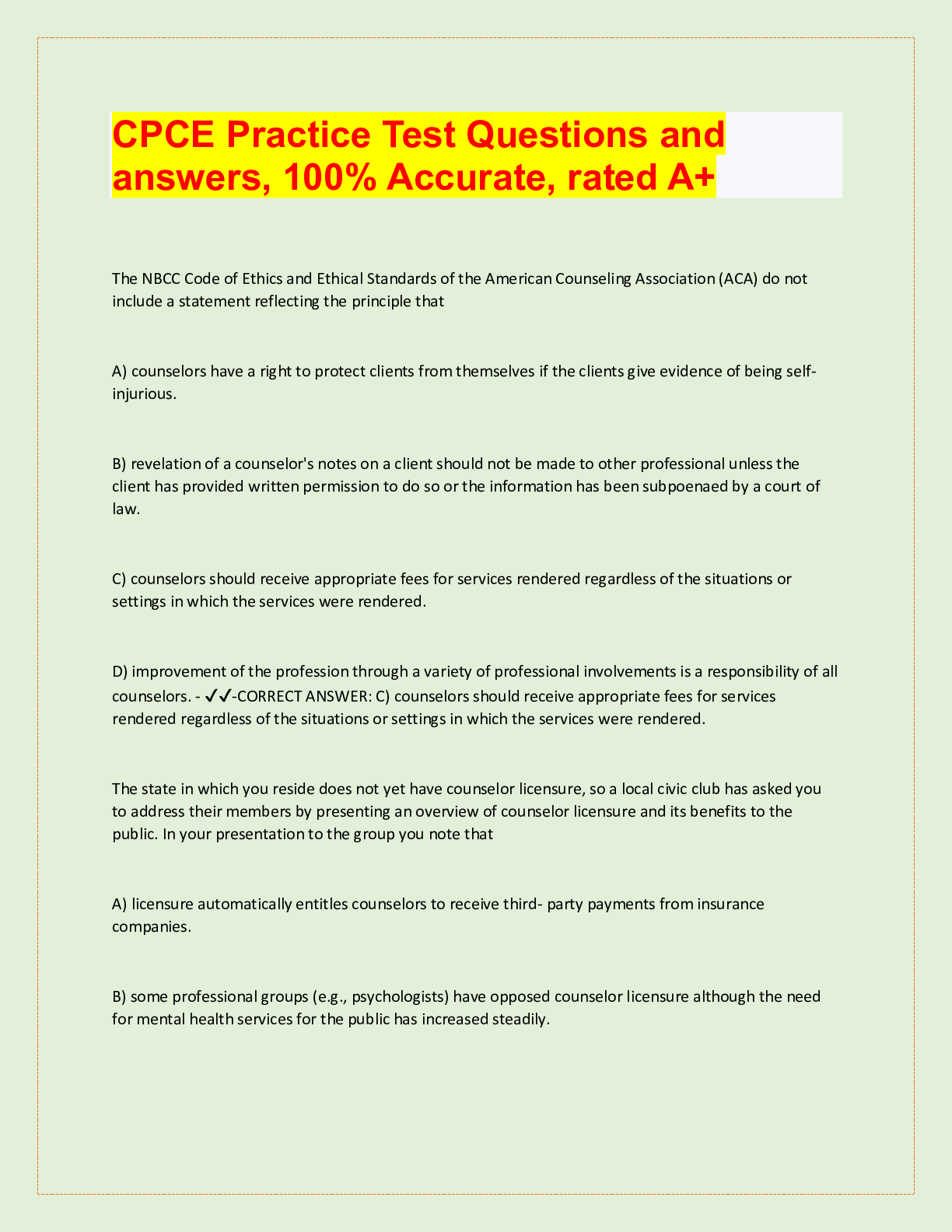
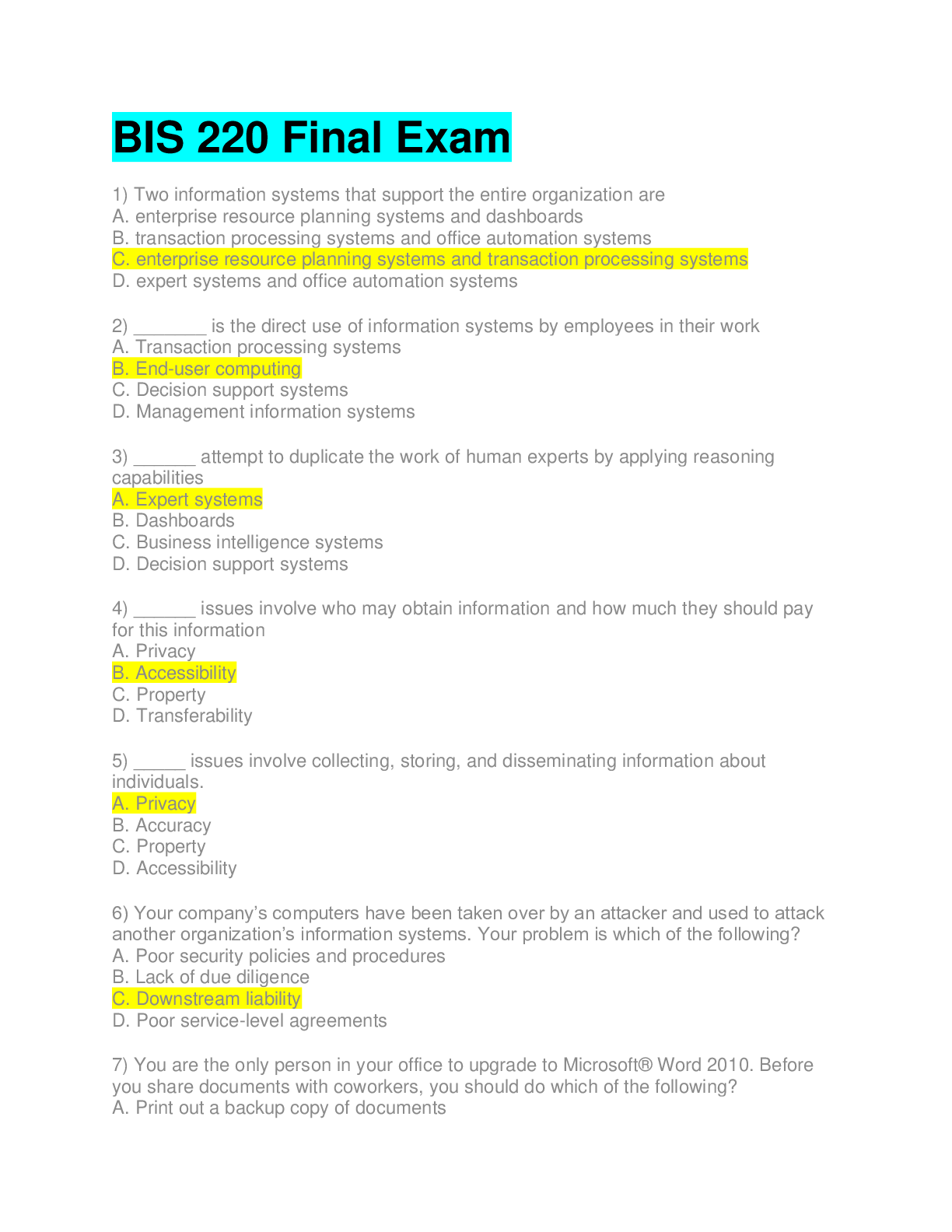

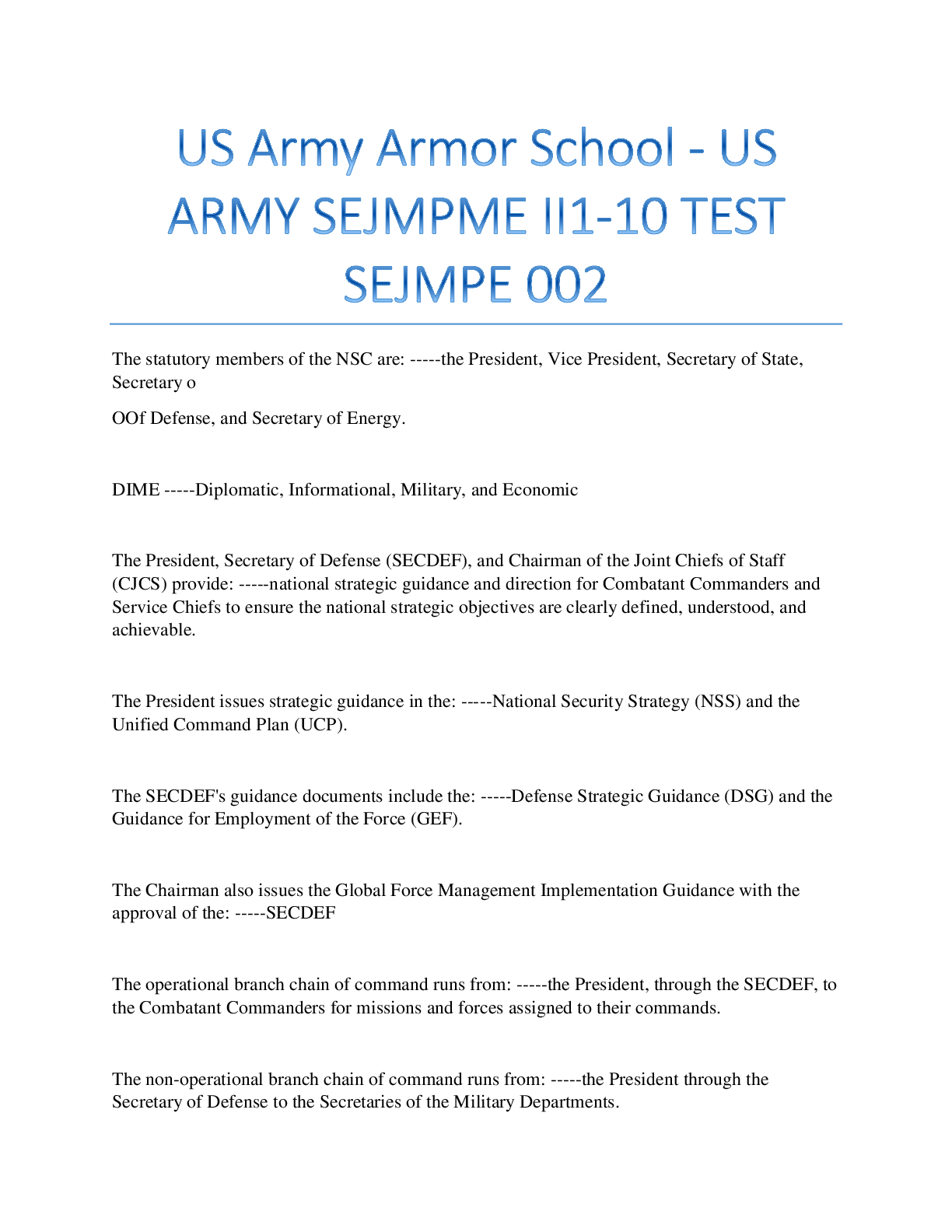



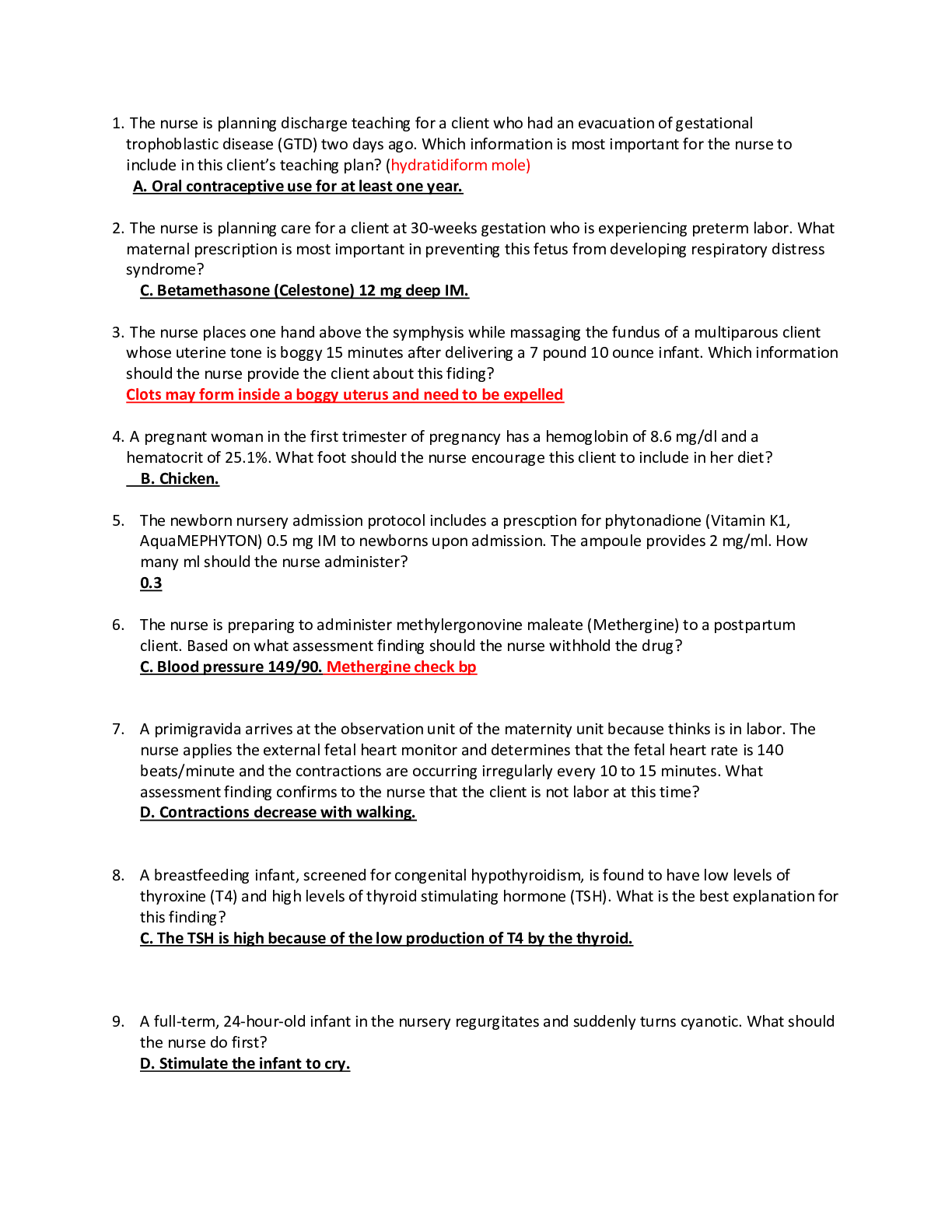
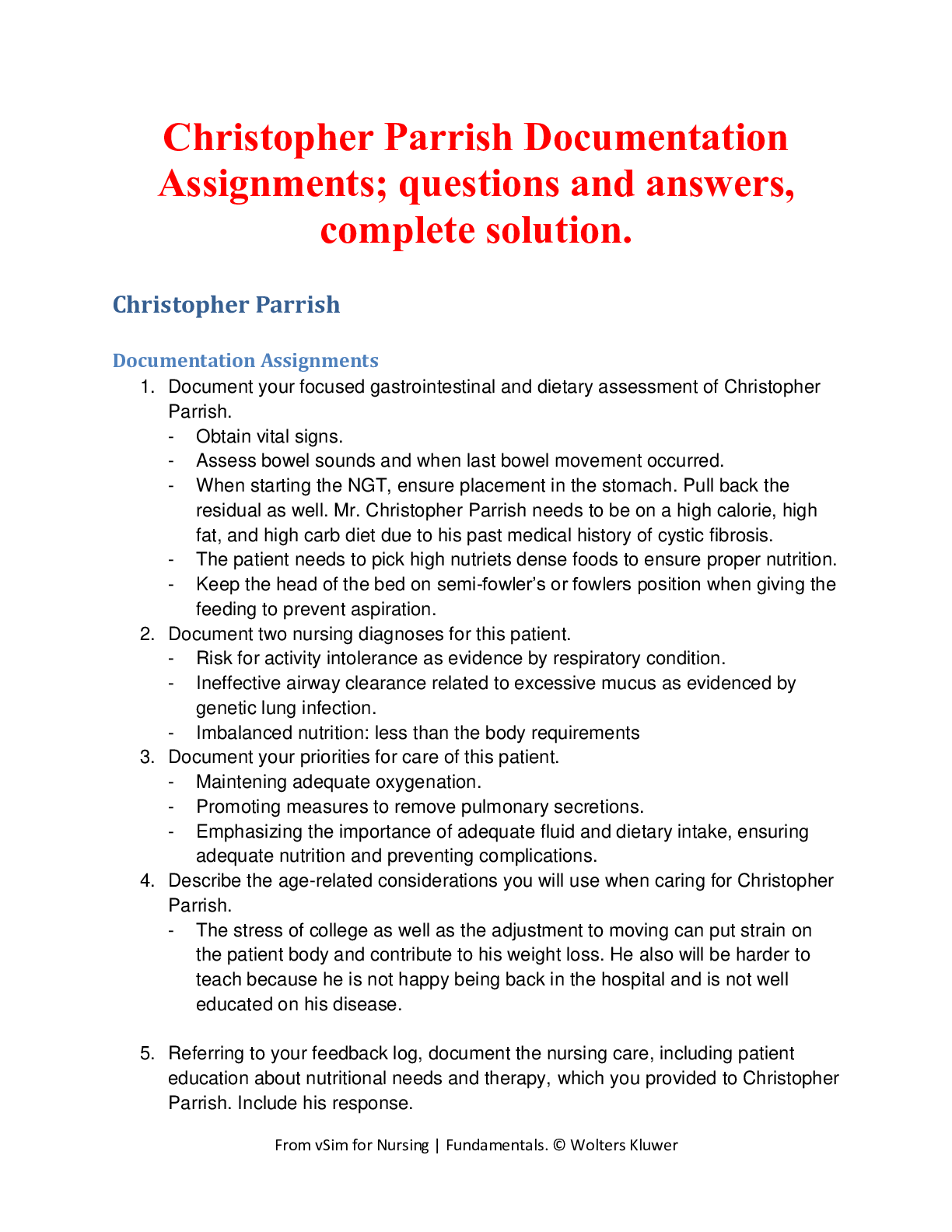
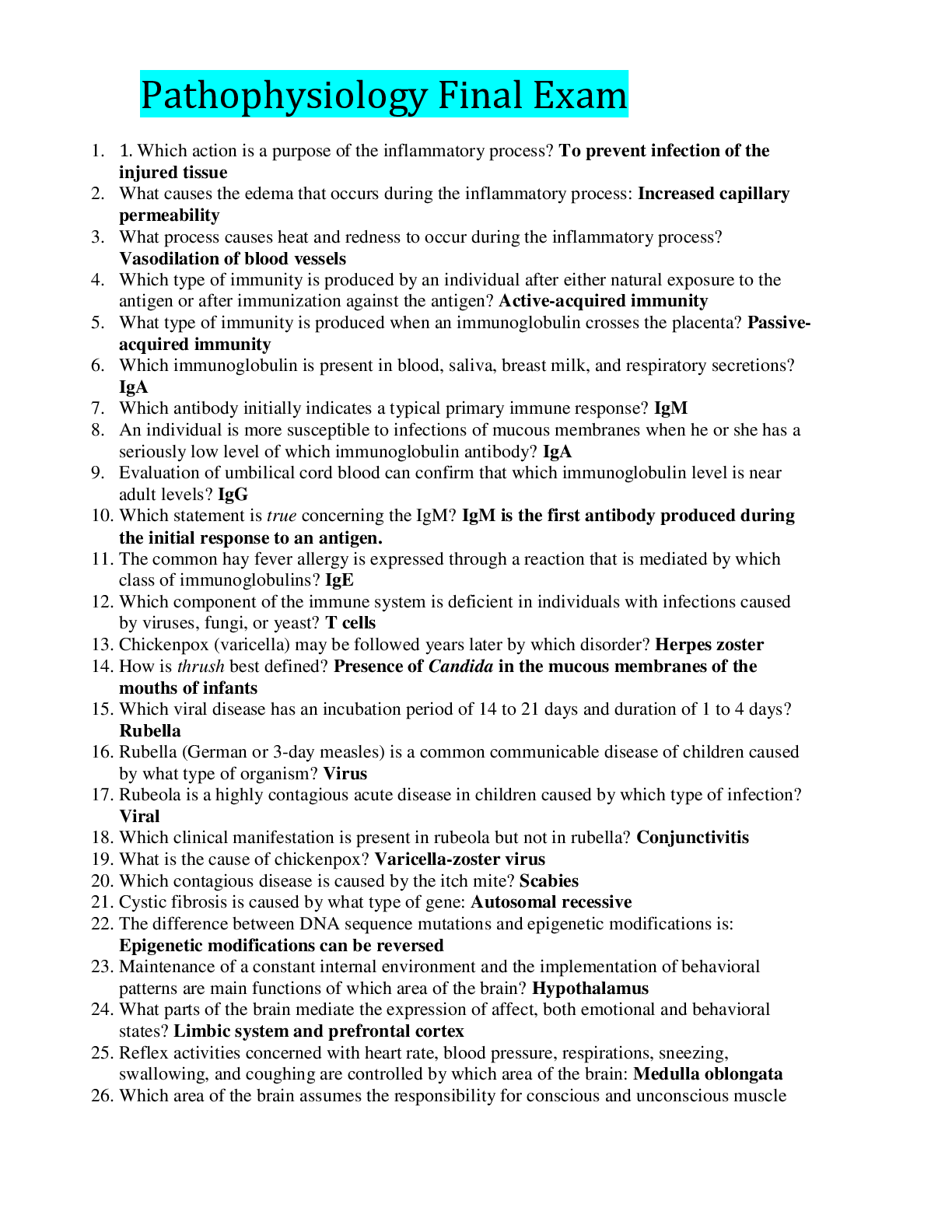
.png)



